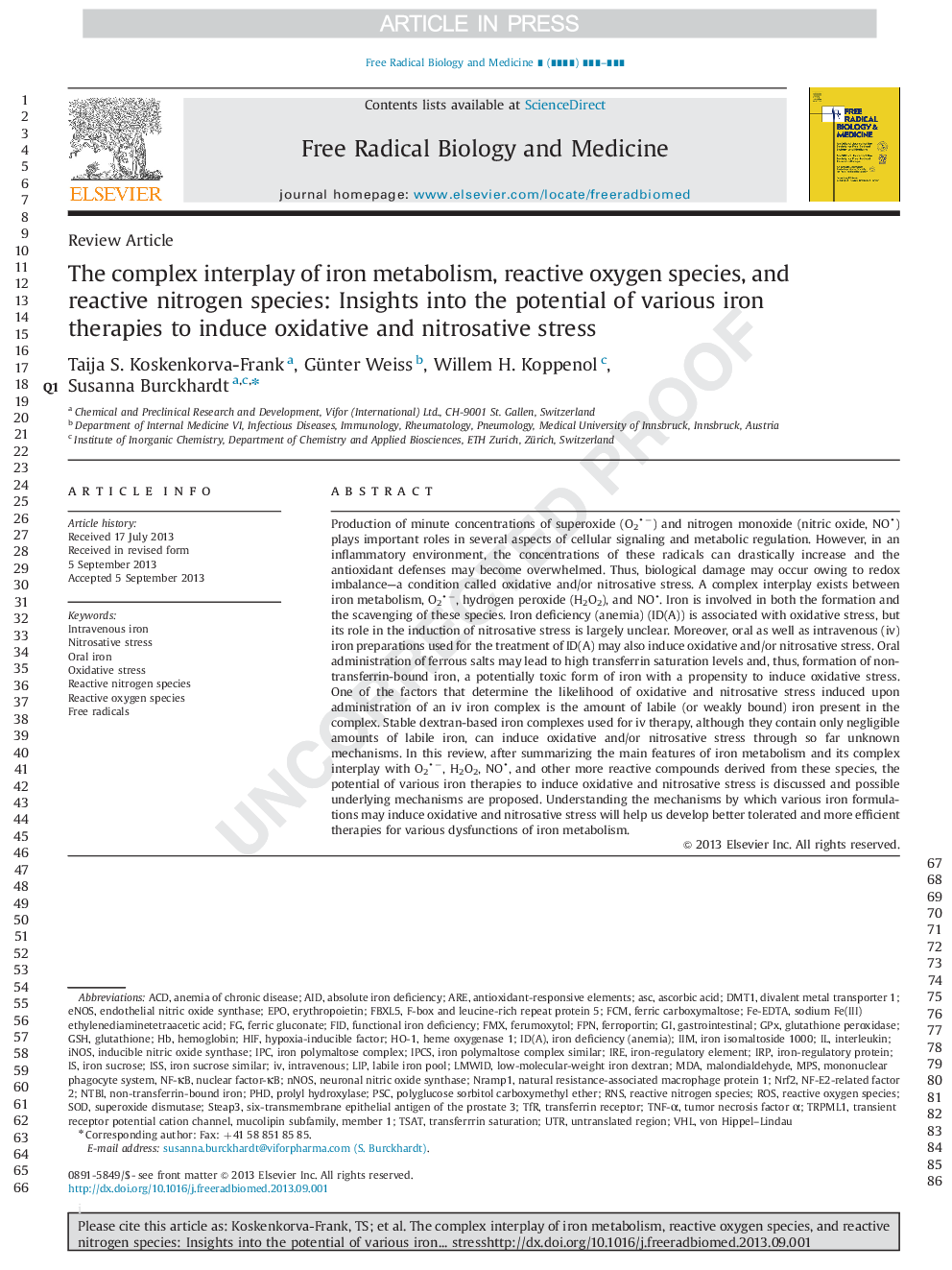| Article ID | Journal | Published Year | Pages | File Type |
|---|---|---|---|---|
| 8270955 | Free Radical Biology and Medicine | 2013 | 22 Pages |
Abstract
Production of minute concentrations of superoxide (O2â) and nitrogen monoxide (nitric oxide, NO) plays important roles in several aspects of cellular signaling and metabolic regulation. However, in an inflammatory environment, the concentrations of these radicals can drastically increase and the antioxidant defenses may become overwhelmed. Thus, biological damage may occur owing to redox imbalance-a condition called oxidative and/or nitrosative stress. A complex interplay exists between iron metabolism, O2â, hydrogen peroxide (H2O2), and NO. Iron is involved in both the formation and the scavenging of these species. Iron deficiency (anemia) (ID(A)) is associated with oxidative stress, but its role in the induction of nitrosative stress is largely unclear. Moreover, oral as well as intravenous (iv) iron preparations used for the treatment of ID(A) may also induce oxidative and/or nitrosative stress. Oral administration of ferrous salts may lead to high transferrin saturation levels and, thus, formation of non-transferrin-bound iron, a potentially toxic form of iron with a propensity to induce oxidative stress. One of the factors that determine the likelihood of oxidative and nitrosative stress induced upon administration of an iv iron complex is the amount of labile (or weakly-bound) iron present in the complex. Stable dextran-based iron complexes used for iv therapy, although they contain only negligible amounts of labile iron, can induce oxidative and/or nitrosative stress through so far unknown mechanisms. In this review, after summarizing the main features of iron metabolism and its complex interplay with O2â, H2O2, NO, and other more reactive compounds derived from these species, the potential of various iron therapies to induce oxidative and nitrosative stress is discussed and possible underlying mechanisms are proposed. Understanding the mechanisms, by which various iron formulations may induce oxidative and nitrosative stress, will help us develop better tolerated and more efficient therapies for various dysfunctions of iron metabolism.
Keywords
HIFGSHGPXIPCsHO-1EPOVHLLIPPSCiNOSIRPRNSACDDMT1FerumoxytoleNOSIPCISSnNOSTFRNatural resistance-associated macrophage protein 1Fe-EDTAMDAIIMFCMFbxl5TRPML1TSATNTBIferroportinNRAMP1FPNASCIRENrf2PHDROSAscorbic acidOral ironIntravenous ironnon-transferrin-bound ironiron-regulatory proteinferric carboxymaltoseerythropoietinVon Hippel–LindauLabile iron poolNitrosative stressinterleukinOxidative stresstumor necrosis factor αIntravenousFIDGastrointestinalFree radicalsIron sucroseSODinducible nitric oxide synthaseendothelial nitric oxide synthaseneuronal nitric oxide synthaseSuperoxide dismutaseNF-E2-related factor 2Hypoxia-inducible factorTNF-αDivalent metal transporter 1UTR یا untranslated regions untranslated regionAREheme oxygenase 1HemoglobinProlyl hydroxylaseAnemia of chronic diseaseFunctional iron deficiencyAIDGlutathioneglutathione peroxidaseFerric gluconatereactive nitrogen speciesReactive oxygen speciestransferrin receptor
Related Topics
Life Sciences
Biochemistry, Genetics and Molecular Biology
Ageing
Authors
Taija S. Koskenkorva-Frank, Günter Weiss, Willem H. Koppenol, Susanna Burckhardt,
